“Motorbike”
by Leon Bridges
From the album Gold-Diggers Sound
Over the past few years, Leon Bridges has established himself as one of the more important new voices in music. Coming off his throwback 2015 debut album, Coming Home, Leon released Good Thing, a sonic exploration of all styles of R&B, three years later. Now, he’s back and furthering his evolution with the new album Gold-Diggers Sound, released in July. Lead track “Motorbike” is all vibe, and just breezes by like a summer wind.
As Leon sings “we don’t stop, but the time do,” it puts you in total relaxation mode, ready to just let go and kick back.
]]>We connected with some of the countless Rams bringing people together to repair and lift up their communities.
A Pro Runner Blows the Whistle on Abusive Training Culture
In 2013, at age 17, Mary Cain was one of the top runners in the world, the youngest U.S. athlete ever to compete on a World Championships team. But soon after joining Nike’s elite Oregon Project to train with head coach Alberto Salazar, her health and her promising pro career deteriorated.
Her coaches forced her to lose weight, which led to the loss of her period for three years and stress-related injuries, including five broken bones, Cain said.
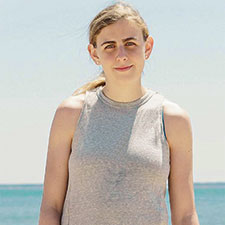
“You don’t go from losing weight to breaking bones in two days, right? There’s usually this long period of time where there’s this physical deterioration,” Cain said at Fordham’s ninth annual Sports Business Symposium, held virtually on March 25. “Throughout the day, I just was more prone to having silly things, like headaches, to just being more hungry, to being a little bit more irritated as a result, and to just being visibly fatigued.”
She began to dread the sport she had loved since fifth grade. Her physical, emotional, and mental health began to spiral downward. She developed an eating disorder and began to cut herself and have suicidal thoughts.
“What once had been something that came naturally to me, this beautiful experience … suddenly became a slog,” Cain said. “The longer that I was in this really circular system, the more my body broke down.”
Cain completed one year at the University of Portland while training with the Oregon Project before transferring to Fordham’s Gabelli School of Business, where she earned a bachelor’s degree in 2019. After moving to New York, she kept training with the Nike project until 2016.
In a November 2019 video piece for The New York Times, Cain said the all-male coaching staff, led by Salazar, did not include a certified sports psychologist or certified nutritionist, and that Salazar had tried to put her on birth control pills to lose weight and harmed her mental health by berating her and humiliating her in front of her fellow athletes.
“Women in sports are treated harsher when it comes to body image,” she said during the Fordham symposium in March. “And I believe the reason is mostly societal—the expectation to be a lighter weight is more attached to [women’s] looks and their meaning. And it’s this really toxic culture that I think permeates professional sports.”
After Cain’s story came out, many other women supported her claims, including Kara Goucher, an Olympic distance runner who had trained under the same Nike program. Salazar denied the allegations of abuse, but several weeks before Cain’s story was published, he received a four-year ban from the sport for doping violations, and Nike had already shut down the Oregon Project.
In January 2020, Nike completed an internal investigation of Cain’s allegations of abuse, and her story helped Nike identify initiatives to “do better in supporting female athletes,” including increasing the number of women coaches in sports and investing in scientific research into the impact of elite training on women and girls.
Today, Cain is the New York City community manager for Tracksmith, a running apparel company. She runs professionally as a member of USA Track & Field and continues to call for reforms, including having teams provide mental health counselors and sports psychologists who are separate from the coaching staff.
She said her goal in sharing her story is to make sure that no other athletes, particularly female athletes, have to go through the suffering she did.
“I hadn’t known that the situation was bad until somebody [told me], ‘That is bad. That shouldn’t happen to you.’ It’s normalized,” she said.
“I realized I didn’t want any other person out there to … be self-loathing, beat themselves up, and have this incredibly negative experience because they were under an emotionally abusive coach and almost didn’t know it.”
—Kelly Kultys, FCRH ’15
A Gun Violence Survivor Works to Heal Social Divisions
Lamont Young knows something about forgiveness and bridging interpersonal divides.
In 1993, he almost died after being shot seven times in the chest—point blank—by an acquaintance who was high on PCP. But he later found the strength to forgive his assailant, and in doing so, he was inspired to pursue a lifelong path of helping others.
That path eventually led him to the Graduate School of Education, where he earned a master’s degree in mental health counseling in 2018.
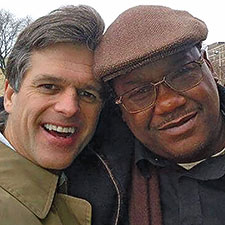
Then he made a career move that led to a personal transformation. He went to work with UNITE, a national initiative co-founded by Special Olympics Chairman Timothy Shriver that seeks to help Americans overcome divisions, and he gained a new perspective.
“I went in with this psychological approach to addressing the human condition and suffering caused by racism and discrimination. I had a burning desire to promote human dignity and shed light on segregation and dehumanization, but I was so caught up in my head trying to find ways to address this,” he said.
“Once I met with the UNITE team, I had a spiritual awakening. I started to address them not from my mind or from my heart, but from my spiritual background. It was transformative to understand that in spite of it all, we have to love, we still have to forgive.”
Young and his mother, Glenda, are featured in The Call to Unite: Voices of Hope and Awakening (Penguin Life/The Open Field), published in March. The book contains an interview with them conducted by Shriver, who knew Young from a young men’s group he once led in New Haven, Connecticut.
“A mother who raises a son who can take on the hardscrabble and often fatal streets of New Haven and not only come through it but come through it with forgiveness and an open heart—that’s a mother I want to learn from,” said Shriver, who spoke about the power of personal transformation at Fordham’s 2019 commencement ceremony, where he received an honorary doctorate.
Shriver said the book’s common thread is that when we treat ourselves and others with dignity, we unlock potential, even during disagreements.
“This is hard emotional, spiritual, political work,” he said. “If you want a quick solution, this is the wrong place. But if you want the best solution, there’s only one way, and that’s to unite.”
In addition to conducting research on dignity and respect for UNITE, Young works with people experiencing homelessness in New Haven at Columbus House and provides psychotherapy at Reliant Behavioral Health Community Service.
And he has learned about some new dimensions of forgiveness. “You can transgress against yourself by not forgiving yourself for some of the things that you haven’t done or some of the time you haven’t spent with your loved ones before they left this Earth,” he said. “I found that very powerful, to understand how to love and forgive yourself in the midst of turmoil and grief in order to free yourself.”
—Patrick Verel, GSAS ’15
A Nonprofit Leader Rescues Food Waste to Relieve Hunger, Promote Community
As the president and CEO of Community Solidarity, Jon Stepanian runs the largest vegetarian hunger relief program in the country. It’s a nonprofit he hopes doesn’t exist in a generation or two.
“When we started, we wanted to build a structure where we could theoretically put ourselves out of business in the communities where we operate,” Stepanian said. “We want to make sure that there’s going to be no need for us in 30 to 40 years if the community itself can take care of these needs.”
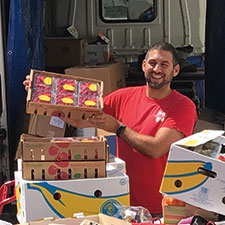
Based on Long Island, Community Solidarity rescues food from being wasted at supermarkets and farms and distributes it to people at food shares across four locations on Long Island and one in Bedford-Stuyvesant, Brooklyn. Each area, he says, is at risk of being a “food desert,” where fresh, nutritious, affordable food is hard to find.
“We rescue food waste because it’s common sense—it’s cheap to do it. But on a more philosophical level, on a more economic level, this is why people in our communities are struggling. We see it as a fundamental problem in our system that’s making people in our community poor and hurting people overseas and also destroying our environment by producing large quantities of stuff that we don’t need,” he said.
“We’re trying to rescue a small portion of that waste and repurpose it for something good, like feeding our neighbors, but we’re also trying to expose the problem.”
Stepanian knew he wanted to focus on helping local communities after graduating from Fordham. As an undergraduate, he studied history and political science—and an internship at the United Nations and a stint working at the American Civil Liberties Union gave him perspective on working within the intergovernmental and nonprofit sectors. Shortly after college, he and his friends started a Food Not Bombs chapter on Long Island, occasionally setting up a food distribution table on weekends.
Before long, he realized he needed to create a more sustainable structure to keep the food distribution going. Community Solidarity, with its 501(c)3 nonprofit status, was born out of this realization, although Stepanian said that a nonhierarchical structure was important from the outset.
“When we decided to become a nonprofit, we said we wanted no lines of demarcation between who can volunteer and who can get food,” he said. “We wanted to make it so you wouldn’t be able to tell if someone’s volunteering or in need or both.”
In a 2018 TEDxNYU talk, Stepanian talked about what he called “the myth of scarcity,” and how a communal response can not only address hunger but also help to create a deeper sense of belonging among neighbors.
“We’re also trying to raise awareness by saying that we will, in 10 years, be the largest hunger relief organization in the country, and we’re doing it for a thousandth of the price that the food banks are doing it, all because of this waste,” Stepanian said.
“This is how abundant that system of waste is. We want to make it eye-opening for people.”
—Adam Kaufman, FCLC ’08
A Familiar Face Offers Financial Literacy Training to Fellow Women of Color
As a young woman growing up in Brooklyn, Felicia Gomes-Gregory knew she wanted two things: to attend Fordham University and to work as a computer scientist. She achieved both.
But now, more than 30 years later, Gomes-Gregory is focused on something new, which she calls her passion project: Heels and Higher Achievement, a nonprofit that empowers women and people of color by helping them learn about finance.
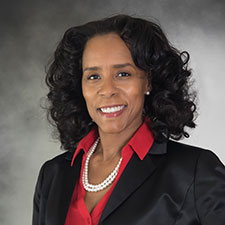
Her path to forming the nonprofit started in 2016, when she received what she calls a blessing in disguise. After a decades-long career at various financial firms in New York City, she was laid off from Neuberger Berman, an employee-owned investment management firm.
She asked herself what she would do next. “In my heart, I’ve always wanted to … get more women involved in technology or finance, and especially women of color, because I never saw anybody that looked like me—or not enough of it,” Gomes-Gregory said.
She kicked off Heels and Higher Achievement (HHA) in 2018, determined to make financial literacy fun while giving a voice to those in her community who are empowering young women in tech, finance, STEM, media, or “whatever it is that they want to do,” she said. “I wanted to create a forum so that people can speak, but mainly speak about financial education.”
That first year, she conducted in-person workshops at schools, churches, and “anywhere anyone would hear me,” Gomes-Gregory said. She’d speak about basic financial literacy concepts and invite people to schedule a complimentary financial review—a kind of “GPS of your money,” she said, “to make sure you can stop working for money at some point and [let]money work for you.”
She also launched an ambassador program to give young girls opportunities to network with professionals and serve their communities through volunteer work. But COVID-19 meant pivoting to online events and workshops in 2020.
In April, HHA sponsored its second annual series of online workshops for Financial Literacy Month, including, for the first time, programming for men. “[Because] of all of the things that were happening in the Black community— between George Floyd, the social issues, COVID—men need to talk, too,” she said.
The digital programming has gone well, she said. She’s hoping to launch a YouTube channel and resume in-person events soon.
“I’m learning that self-care and self-preservation—from a financial, physical, mental, and spiritual [standpoint]—are so very important,” she said. “And I didn’t learn this until I was 50. So, now I’m teaching all of the young ’uns. ‘Take care of yourself first. You’re important.’”
—Sierra McCleary-Harris
Students Share Their Expertise with Bronx Businesses
When the pandemic upended everything in March 2020, Rich Shrestha was working on a research project about consumer behavior in the Bronx. As the economy went into a tailspin, his mind went back to his childhood in New Haven, Connecticut, where his father ran a Subway franchise for a decade.
“I saw him always grinding away every day, putting in 12-hour days. So, I can sympathize with the small business owners who are trying to survive in the age of COVID,” he said.
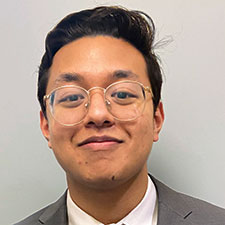
Shrestha, a rising senior majoring in economics at Fordham College at Rose Hill and a member of the University’s Social Innovation Collaboratory, reached out to friends he thought might be interested in helping small businesses.
Diontay Santiago, then a senior majoring in marketing at the Gabelli School of Business, was one of those who answered the call. In June 2020, they launched the Fordham Business Development Collaboratory. The student-run group, comprising more than 70 members, is split into teams that assist clients with finance, marketing, compliance, technology, and communications. Students offer their advice free of charge, relying on lessons they’ve learned in classes. They also conduct research, develop industry reports, and create case studies and videos for Bronx businesses.
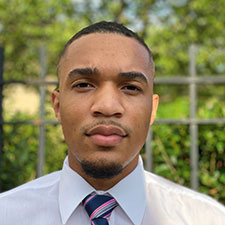
For Santiago, who graduated from Fordham in May and had served as president of ASILI, the Black Student Alliance, the group has been a way to lift up the borough he has called home his whole life. “Doing this sort of thing weds the school to its actual geographic location and allows it to give back to the community it’s inhabited for the last two centuries or so. So when Rich presented me with the opportunity to work with him, I jumped at it.”
The group’s clients have included restaurants, nonprofits, a software company, and an insurance firm. In addition to word-of mouth and its website (fordhambdc.org), the group has connected with clients through the South Bronx Overall Economic Development Corporation.
Sadibou Sylla, the interim director of Fordham’s Social Innovation Collaboratory and an adjunct professor at the Gabelli School, said that all who contribute to the group personify what it means to be a “changemaker.”
“They understand that it is only in serving all that we serve ourselves,” he said, “and that business is nothing but an instrument for helping society.”
Shrestha is optimistic that the group will live on long after he and his classmates graduate.
“This is an opportunity to gain an understanding of the community you’re in, and how we can be a better part of it and better neighbors,” he said. “I think a lot of students are starting to realize how important that is.”
—Patrick Verel, GSAS ’15
Do you know a Fordham “Changemaker”?
Who are the unsung Rams working to foster collaboration and change in your community? Tell us about the people whose stories you’d like us to share. Write to us at [email protected].
That question was at the heart of Communication Ethics and the Public Sphere, a course taught by Fordham professor Diana Kamin, Ph.D., in partnership with the Correctional Association of New York (CANY), the only independent organization in the state with the authority to monitor prisons and report their findings to the legislature and the broader public.
“Going back to ancient Greece, the public sphere is defined by the exclusion of incarcerated populations,” Kamin said, noting that CANY’s mission is “to create a public platform and access for a group that has traditionally been excluded.”
Kamin met with Jennifer Scaife, executive director of CANY, and they determined that students in the class would engage in media monitoring for the organization, providing tips to help CANY create media campaigns on four topics: parole, prisons and food, COVID-19 vaccines and prisons, and the 50th anniversary of the uprisings at Attica Correctional Facility in New York state.
“With CANY, our thoughts and research were actually going to people who want to use it to help others,” said Regine Anastacio, who graduated from Fordham College at Lincoln Center in May. “This project opened up my eyes to whose voices were being heard within the public sphere and whose voices were being neglected during times of uncertainty.”
For their final projects, students presented their research and the private Instagram feeds they created as campaign models to Tyrell Muhammad and Felicia Henry, a senior advocate and a research fellow, respectively, at CANY.
“What you’re doing is so important for our activism,” Muhammad told the students during their May 4 class. “I want to continue working with you because you’re incredible young people. You’re going to change some minds.”
Kamin said the partnership with CANY has helped students appreciate “the value [they]can bring to nonprofit and community-driven organizations.”
Gillian Russo, who graduated from Fordham College at Lincoln Center in May, said the course helped prepare her for a career in journalism. She said that out of approximately 20 stories she read on decarceration during the course, only two included quotes from an incarcerated person.
“It made me think about how as a journalist I should strive to seek out the points of view of the people most directly affected by any issue I write about,” she said.
]]>With more than 15 Fordham students gathered around him, López- Jensen encouraged them to consider what used to lie beneath where they were standing.
“Along the river, especially up here in the northern part, we’d find neighborhoods. And where there’s sand and where there’s rocks, if we were to walk around and just look, we would find stuff from the old communities that used to live along the banks here,” said López- Jensen, an adjunct professor at Fordham.
The reservoir covers Kensico, a mill village established in the early 1700s, López-Jensen said, reminding the class of their reading of The Bronx River in History & Folklore (Arcadia Publishing, 2015) by Stephen Paul DeVillo. Before the dam was completed in 1917 to help provide water to the growing New York City area, the city condemned properties along the river, dismantling homes and businesses before flooding the village to make room for the reservoir.
“Think about the history—if you just came here, you would be like, ‘Wow,’” he said, referring to the majestic dam and expansive public park below. “But you read that there’s an old village underneath all this, and you can think about displacement, and the history of displacement and how so much of New York City is just one displaced community after another. The Bronx River has a little bit to do with that. In order to make the Bronx River Parkway, so many neighborhoods had to be cleared out. … And so there’s all these layers of history in every site.”
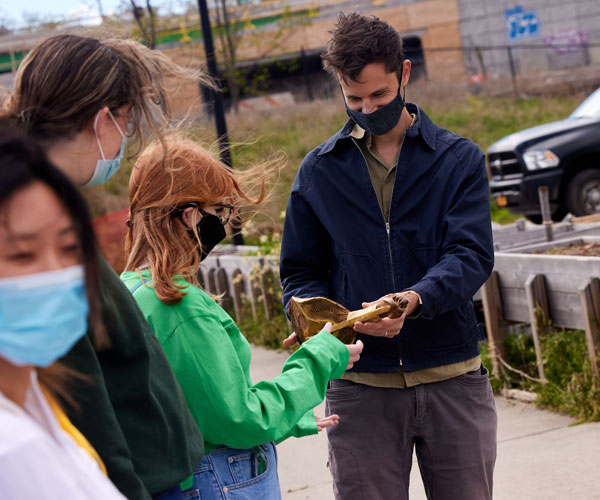
López-Jensen’s outdoor lesson was part of Art and Action on the Bronx River, a new Fordham course created with support from the University’s Center for Community Engaged Learning and taught in partnership with the Bronx River Alliance, a nonprofit established 20 years ago to help revitalize and protect the river and its surrounding communities.
“It’s an art class,” López-Jensen said, but students learn about the history of the river, its ecology, its relationship to surrounding communities, and its connection to New York City’s watershed. Students can adapt the coursework, including video, photography, mapmaking, and drawing assignments, to fit their majors, such as environmental science or urban studies, he added. “And it’s a chance to go outside.”
Angela Payne, a rising junior at Fordham College at Rose Hill, decided to take the class because it combined her primary academic interests.
“I’m a visual arts major and an environmental studies minor,” she said. “It’s really interesting … [to learn]the history of the Bronx River—I had never really considered it before, but I learned so much about this area.”
Mapping and Drawing the River
In his own work, López-Jensen, a multidisciplinary artist and a former Guggenheim fellow, investigates the relationship between local landscapes and the people who inhabit them. He teaches his students how to conduct detailed explorations of the Bronx River—on foot, through photography and video, and by researching and mapping its characteristics.
For one mapmaking project, Gregory Yared, a rising junior at Fordham, spent a day along the river’s banks in Tuckahoe, a Westchester County village about eight miles north of the Rose Hill campus.
“At first I thought I would mark each space where animals could access the water,” he said. “But then, after talking to our professor about ‘desire paths,’” informal tracks that people and animals have made outside of designated routes,“I was like, ‘That’s really cool.’ I thought it would be really interesting to map human and animal
desire paths to the river.”
Yared said the map he created could be used not only by civic planners, who sometimes decide to transform desire paths into formal trails, but also by conservationists looking to control the negative impacts of soil erosion and track how animals get near the water. Yared’s project, along with all of the other students’ work from the course, will become part of the Bronx River Alliance’s collection.
“Because this class has never existed, and so little attention has been given to the Bronx River, we’re basically building an archive of art and design that will be made publicly available,” López-Jensen said.

Tracing the River’s Troubled, Inspiring History
Another goal of the course is to help students understand the troubled environmental history of the waterway and how, beginning in the 1970s, Bronx residents worked together to revitalize the river for the ecological, recreational, educational, and economic benefit of the borough.
Four hundred years ago, the river was called the Aquahung, or “River of High Bluffs,” by the Native Americans who lived in “large settlements along the estuary, where they could harvest an abundance of seafood, especially oysters,” DeVillo wrote in The Bronx River in History & Folklore. After the arrival of European colonists, including a Swedish-born settler named Jonas Bronck, who purchased land near the river in 1639 (and who later became the river’s namesake), many mills and towns began to grow.
As early as the 19th century, the river, formerly home to a variety of plants and wildlife, entered a long period of environmental degradation, due to poor sanitation practices and industrialization, including the construction of the New York Central Railroad. By the late 1800s, a city commission reported that the river was “rapidly becoming an open sewer.” And threats to the river’s health continued to mount amid increasing urbanization in the 20th century.
In the early 1970s, however, “the river’s degradation would inspire a series of volunteer citizen actions that, in time, would produce a remarkable turnaround,” wrote DeVillo, a former development coordinator of the Bronx River Alliance.
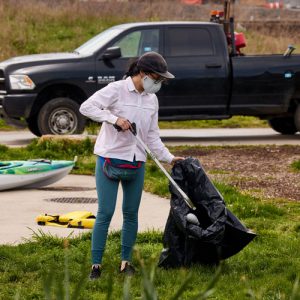
Bronx residents worked together to start cleaning up the river, not only removing debris—including washing machines, cars, and countless tires—but also getting rid of invasive vines; restoring some native plants and trees; stabilizing banks to help stop erosion; reintroducing oyster beds to increase biodiversity and help purify the mouth of the river; and creating a series of riverside parks as part of a Bronx River Greenway. By 2012, eight miles of the Bronx River were designated as a National Water Trail, highlighting the successful efforts
of the revitalization.
Today, the Bronx River Alliance and other nonprofit organizations in the area continue to work to protect and improve the river and its neighboring communities.
Fordham students in López-Jensen’s class were a part of some of these ongoing stewardship efforts on April 30, when they met with a guide from the Bronx River Alliance at Concrete Plant Park, a former industrial site where the nonprofit has reestablished salt marshes and helped add a waterfront promenade and boat launch. On a bright, windy day, the students set off in kayaks to pick up marine trash, photograph the river, and learn about the estuary and conservation efforts.
Partnering with Local Communities
For Zoey Liu, a 2021 graduate of Fordham College at Lincoln Center who majored in communications, the course made her feel more connected to New York City.
“It’s been such a great experience for me to see what’s around our Bronx campus, and see the history around it. It makes me want to stay here even after graduation,” she said.
Her mapping project for the class took a different direction after the rise in attacks against people of Asian and Pacific Islander descent during the spring. She decided to plot Asian American and Pacific Islander communities and organizations located along the Bronx River.
“This can be a way to connect with Asian American communities within the Bronx, which is kind of an erased group—right now, there’s not a ton of information online,” she said. “So I’ve been doing some research. There’s a big Cambodian neighborhood up here, there’s a lot of Korean Americans as well. So I plan on seeing their relationship with the Bronx River. And not only focusing on the literal aspects, like the trees or the plants, but also the people in my community and how they have that relationship with the Bronx River.”
The idea came to Liu, who is Asian American, after talking with López-Jensen about how the rise in violence and discrimination against Asian Americans and Pacific Islanders has affected her personally.
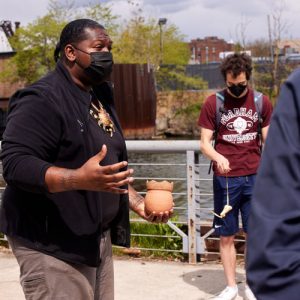
“The last month has been kind of depressing for me,” she said in April. “There was a week when we were supposed to go out on our own little journeys. And I was like, ‘I don’t want to do that by myself right now, especially with everything that’s been happening, even in broad daylight. And then he brought up, ‘Well, if that’s how you feel, especially towards your own experience right now, how can you … take charge of that narrative? If that’s how you feel, put that into your project.’”
López-Jensen said these are the types of lessons about community, and about how the river “connects the Bronx and cuts the Bronx,” that he wants his students to take away from the course.
“We’ve been researching the history,” he said. “It’s such a close and important landmark for them—the Bronx River—and most of the kids hadn’t visited it before.”
Offering a new course, particularly one that requires hands-on fieldwork, can be challenging in normal times, let alone during a pandemic, but López-Jensen said his students adapted well and appreciated the opportunity to get outside.
“It’s such a hard thing to get across, that this is actually what learning can look like—being someplace, being able to tell a story about it,” he said.
—Kelly Kultys, FCRH ’15, is an assistant editor of this magazine.
]]>This spring, UNHP got some help from Fordham students enrolled in Spanish for Heritage Speakers, an undergraduate course taught by professor Miguel García, Ph.D. García’s course helps heritage speakers—people who grew up speaking at least some Spanish at home—develop their grammar, writing, and reading comprehension skills. But it’s about more than mechanics; students also explore issues important to the Latinx community, including immigration, identity, and race relations.
Enter the partnership with UNHP, which was founded in 1983 with help from the University and has a long history of working with Fordham. Aware that the nonprofit was interested in recruiting more volunteers to help during tax season, Julie Gafney, Ph.D., executive director of Fordham’s Center for Community Engaged Learning, played matchmaker.
“I knew that Miguel was looking for opportunities for his [students]to spend some time in the Bronx, getting to know the Bronx community, and … it just seemed like a good fit,” Gafney said.
And it was. During the semester, students used their newly honed language skills to volunteer weekly with the organization’s virtual tax program. They spoke with Bronx residents who called UNHP’s tax hotline and helped them begin the process of filing virtually. Students were hands-on throughout the process, from asking filers preliminary income and technology questions to ensure they had the necessary forms, to using Google Meet to verify a filer’s identity and review their documents.
For many students, working with Spanish-speaking Bronx residents in this way hit close to home. Rising sophomore Thairich Escotto acts as an occasional translator for her mother, helping her complete forms and understand official documents. She’s also a full-time paraprofessional for the New York City Department of Education, where one of her duties is to serve as a Spanish translator.
“I wanted to improve upon [my Spanish]because although I do feel like I speak it and write it well, there are a lot of conventions that I have trouble with, so I think that this class really has helped me improve upon that, and, grammatically speaking, I’m speaking so much better in Spanish,” she said.
And although she wishes she could have worked with people “under different circumstances, maybe in person,” she said the course “really helped me feel like I was contributing to my community.”
For Anna Margarita Canero, GSAS ’21, UNHP’s volunteer coordinator, the collaboration was a success.
“Having Spanish-speaking students on the phones was a tremendous help, especially since taxes can be a sensitive topic. We are so grateful for our student volunteers who took the time to learn the virtual tax process this year,” she said. “Having enthusiastic, patient, and hard-working volunteers made all the difference.”
]]>“My vision is to utilize Fordham athletics to elevate the entire institution, to elevate applications, and to be the leader in diversity and inclusion,” he said. “I want us to be a source of school spirit, school pride. I want athletics to support every pillar and priority of Educating for Justice, the University strategic plan.”
Kull, who joined Fordham four years ago as senior director of development for athletics and senior associate athletic director, now oversees Fordham’s 23 varsity sports programs, about 100 coaches and staff, and more than 500 student-athletes. And he reports directly to the president of the University, Joseph M. McShane, S.J., who has praised Kull for his “commitment to excellence” and “the ease with which he connects with all areas of the University.”
“The culture and environment that I’d like to create and build within athletics is one that’s inclusive for the entire campus,” Kull said. “I want to very much engage the rest of the University, as well as our alumni.”
And while the pandemic has been a challenging time for athletics departments across the country, with games and tournaments canceled and teammates going months without being able to practice together, Kull said he took the opportunity to solidify University-wide engagement and focus on student-athletes’ needs.
“Within six months, I had those kinds of relationships with every department on campus because of what we’ve had to go through, because of how we had to help each other … make sure the best interest of the student is taking place, whether that be mentally, emotionally, or physically,” Kull said. And students have responded with initiatives like Fordham Connect, a student-run group that “aims to erase the stigma around vulnerability in sport.”
“How do we talk about the whole Fordham experience from a student-athlete perspective?” Kull said. “Not just success on the playing field, but success in the classroom, and then career services and job placement.”
Not one to leave his fundraising background completely behind, Kull also hopes to bolster giving in support of athletics and has already launched the Men’s Basketball New Era Fund, which has received $1.3 million in gifts and pledges.
As for success on the playing field, Kull is hoping to build on recent conference titles, including ones in women’s basketball, men’s soccer, and baseball. Among his first big moves as athletics director was hiring Kyle Neptune as the new men’s basketball head coach.
“He knows what it takes to recruit, develop, and evaluate talent,” Kull said of Neptune, “and then bring on student-athletes that not only will have success on the basketball court but also make us very proud in terms of our Jesuit mission and values of education, service, and leadership.”
]]>
“He’s more ready to be a head coach than most young guys, X’s and O’s-wise, and I think he’s got great character, great leadership skills,” Wright told the New York Post in March. “I think he’s going to be an outstanding head coach.”
Here are five other things to know about Neptune as he prepares for his first season at Rose Hill.
His New York City Roots Run Deep
Neptune grew up in Clinton Hill, Brooklyn, and his parents still live there. He attended Brooklyn Friends School, where he played on the 2003 state championship team. He even played in the Rose Hill Gym during his Amateur Athletic Union days. He hopes his New York connections, and those of the staff he’s building, will have a positive impact at Fordham.
“I am very proud about being from New York,” he says. “And our staff right now, most of our guys have New York City roots, and we want that reflected on our team. But not just New York City, the entire East Coast—I think we want to be aggressive in [recruiting players from]those regions.”
He Could Have Seen Himself as a Fordham Student
Although he played basketball at Lehigh University, where he earned a degree in journalism and was a member of the 2004 NCAA Tournament team, Neptune believes he would have thrived as a student-athlete at Fordham. That’s part of what attracted him to the coaching job.
“It’s the type of school I would have liked to go to,” Neptune says, citing “the mission, the high-level education, the location,” and the quality of play in the “very competitive” Atlantic 10 conference. After “interviewing for the job and seeing how dynamic Ed Kull, the athletics director, is,” Neptune adds, he was convinced Rose Hill is where he wants to be.
He Wants the Rams to Play a Tough Style
While part of Neptune’s job will be to recruit top talent, once players arrive on campus, he wants to instill a team culture centered on toughness and work ethic. Noting the qualities he saw in former Villanova players now thriving in the NBA, Neptune says, “The things that separate you are how hard you’re gonna work, your habits, and your character.” And in a conversation with A10Talk, Neptune said he wants the Rams “to be known as a tough, nasty bunch. I want to be a team that no one wants to play against.”
He Knows How to Connect with Young People
Neptune is known for forming strong relationships with players and for demonstrating, as Jay Wright once put it, “all the qualities you want to see in a young coach—commitment, passion, and the ability to communicate with young people.” He has stayed in touch with former Villanova players in the NBA, including Mikal Bridges, Jalen Brunson, Donte DiVincenzo, and Eric Paschall, who began his college playing career at Fordham. Those relationships tend to complicate his NBA rooting interests, though. “It’s kind of hard to root for any team when you know someone on the other team and you’re so invested in their success,” he says.
He’s Impressed by the Passion of Fordham Fans and the Alumni Network
“You walk around the campus and you just feel the energy and the passion from the people,” Neptune says. “I knew there was a wide-ranging, proud alumni base, but moving around the city and in meetings with people, I’ll wear my Fordham stuff, and people notice. It’s been exciting to see how engaged people are.”
That engagement—and excitement about Neptune’s hiring—was on display in a Fordham athletics welcome video featuring alumni sportscasters Jack Armstrong, FCLC ’86, GSAS ’88; Chris Carrino, GABELLI ’92; Jack Curry, FCRH ’86; Spero Dedes, FCRH ’01; Michael Kay, FCRH ’82; Ryan Ruocco, FCRH ’08; and Mike Yam, FCRH ’03. Neptune would like to see that enthusiasm turn the Rose Hill Gym into a place that opponents don’t want to visit. “I hope the fans are really hard on the other team,” he says. “We want it to be packed every night.”
]]>Educators with the New York Transit Museum guided attendees through two centuries of transit history as part of the event, “Sustainability of Public Transportation,” organized by the Office of Alumni Relations.

The presentation was framed by themes of economics and environmental and social sustainability. “We’re talking about public transportation systems that should be affordable, efficient, provide access to all, minimize their environmental footprint, and mitigate the effects of climate change,” said Kate Lanceley, an educator with the museum. She spoke—via Zoom—from inside a vintage train car at the museum, housed in a decommissioned subway station in downtown Brooklyn.
Thus began the tour. The first stop? New York City of 1827, a time when public transportation began with horse-drawn omnibuses, which offered bumpy rides on wooden wheels along cobblestone streets. Riders paid about 12 pennies, “which was really a lot of money at the time”—unaffordable for most people, Lanceley said.
Fares were lower, and the ride smoother, in horsecars riding on tracks, which debuted in 1832. But the cars moved slowly, about 8 mph along congested streets, and the horses’ waste “was a massive problem” because no formal department of sanitation existed yet, Lanceley said. While horse-drawn transport would continue, alternatives were on the way.
Steam-Powered Trains Arrive

Next, the tour pulled in at New York of the 1870s, when elevated steam-powered trains began service in the city, providing a faster ride—12 to 15 mph along a dedicated right-of-way—and enabling riders to live in spacious uptown areas while commuting to lower Manhattan. But the trains spewed a lot of pollution, blocked the light on city streets, and “were incredibly noisy,” Lanceley said.
And they were vulnerable to the elements—as shown when a blizzard snarled the trains and immobilized riders in 1888. The disaster is credited with catalyzing the formation of a rapid transit commission that examined options for a subway, Lanceley said, adding that some elevated train lines would be incorporated in the subway system.
The First Subway Leaves the Station
Next, the presentation arrived at the founding of the city’s first subway line, built between 1900 and 1904, which began at City Hall and stretched up the east side of Manhattan. Lanceley noted that early trains had overhead fans, “considered a big improvement” at the time. “Today, we look at the fan in horror,” she said. “Imagine if you were really tall and you stretched.”
The subway’s electrified cars were made possible by the same technology that powered streetcars and trolleys, which posed safety concerns as they moved through city streets crowded with pedestrians.
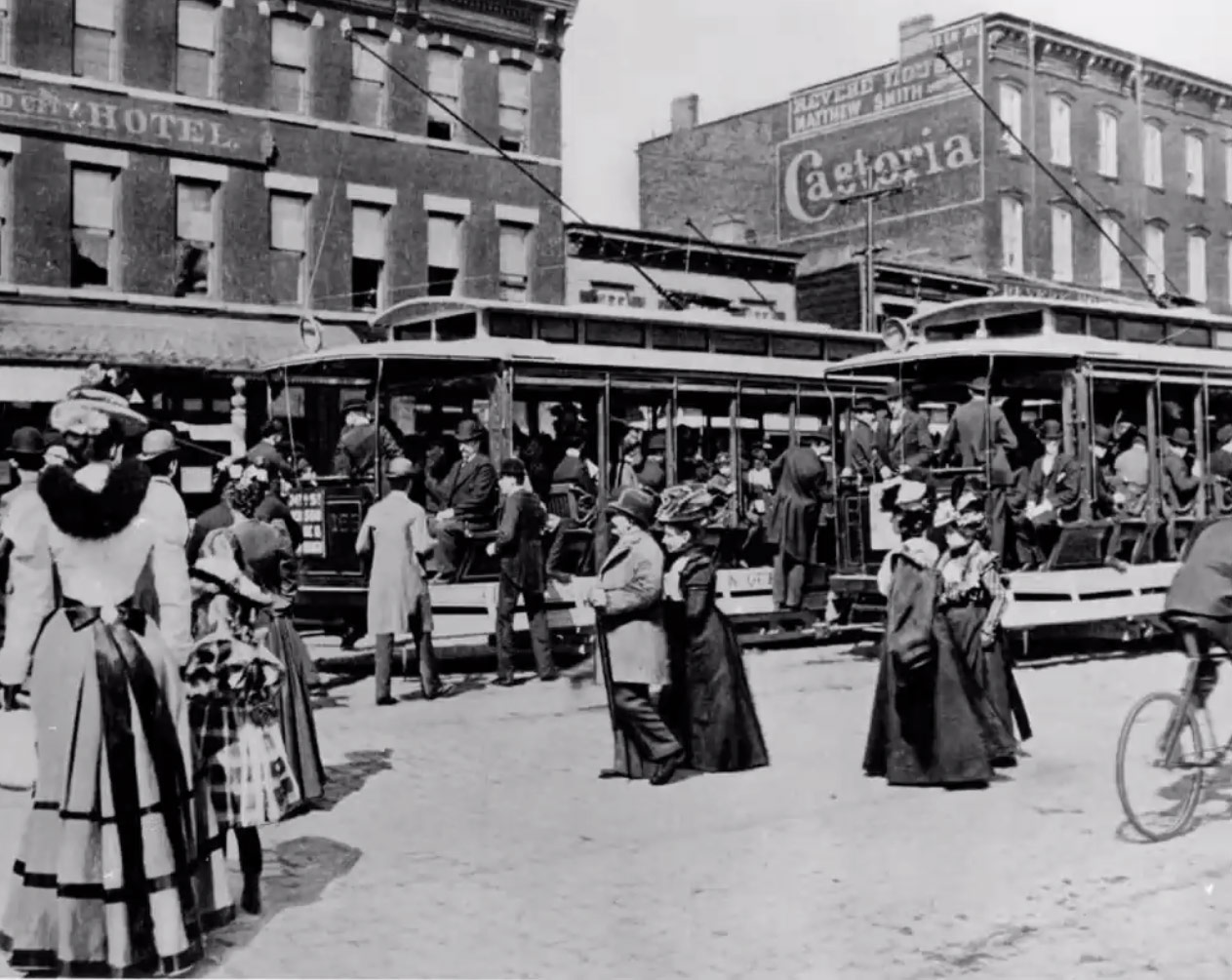
“Everybody is taking their lives into their own hands just crossing the street,” Lanceley said while showing a video from 1903 that appeared to be shot from a moving trolley. In fact, the dodging of streetcars was memorialized in the name of an iconic sports team, the Brooklyn Dodgers, Lanceley noted.
Also essential to the subway’s creation was the 1897 invention of multiple unit control, or putting a motor truck on each car, which allowed more cars to be strung together, since they didn’t all need to be moved by a single engine.
The final stop on the tour was present-day New York, where the work to make the subway system more efficient and accessible continues. The city has begun installing a signaling system using transponders to precisely locate trains so they can run more closely together, allowing more of them to be in service at once, Lanceley said. And the system also faces a formidable task in making all its stations accessible; right now, just 25 percent have elevators, she said.
Climate Change Considerations
Other work on the system highlights the looming issue of climate change, she said, describing upgrades to lower Manhattan subway stations to help them withstand storm surges like the one that devastated the South Ferry station during Hurricane Sandy in 2012.
The hurricane “was really a huge wake-up call for the transit system,” Lanceley said. “Rising sea levels are going to be an ongoing challenge.”
The city is also confronting climate change via changes to the bus system, which was expanded in Manhattan in the 1930s to provide a safer alternative to trolleys, she said. The expected switch to an all-electric city bus fleet by 2040 will not only reduce carbon pollution but also combat that other scourge of New York transit: noise.
That much was clear when she chatted with a driver of one of the new electric buses, Lanceley said: “She really emphasized just how quiet they are, compared with the old noisy diesel buses.”
Alumni attended the event from as far away as Texas and California, taking advantage of the virtual format that alumni relations adopted for cultural and entertainment events with the onset of the coronavirus pandemic. In-person cultural and entertainment events for alumni will resume in the fall, although virtual events will likely continue as well.
]]>Ian Brownlee, LAW ’85, and 28 other federal employees are finalists for the 2021 Samuel J. Heyman Service to America Medals, or “Sammies,” according to a May 2 announcement by the nonprofit, nonpartisan Partnership for Public Service, which awards the medal.
After the pandemic prompted border closures, flight cancellations, and lockdowns worldwide, Brownlee organized and led a multiagency task force established by the State Department. Over the course of six months, members brought home Americans from nearly 150 countries under the leadership of Brownlee, now the acting assistant secretary for consular affairs.
“We had an unprecedented disaster with a disease shutting down global borders all at once and stranding Americans who needed to get home. We have never dealt with the repatriation of Americans at this scale,” said Hugo Yon, acting principal deputy assistant secretary of state for business and economic affairs, in a statement from the Partnership for Public Service.
The task force faced massive challenges in bringing people home safely in the middle of a pandemic—complex international regulations and procedures, strained relations with some of the countries where Americans were stuck, and the fluidity of travel restrictions, the statement said.
The task force arranged more than 1,000 flights and other modes of transport for Americans in cities, towns, and remote areas around the world. The Air Force was called upon to airlift a 55-member U.S. women’s tackle football team from Honduras to South Carolina. The State Department rented boats for Americans marooned on the Amazon River and sent a bus for American campers at the edge of the Sahara desert, the statement said.
“Ian Brownlee was the linchpin, the leader who pulled everyone together and orchestrated the entire operation,” Yon said.
Brownlee’s team members held conference calls every morning and evening, seven days a week, to share updates and concerns. He also helped brief Congress and the media about repatriation efforts.
‘Head of Mission Control’
He was, in effect, the “head of mission control” who had to deal with “different rules for each sovereign government and balance competing interests from multiple agencies, Congress, and the public,” said Kevin O’Reilly, deputy assistant secretary of state for the Bureau of Western Hemisphere Affairs.
“He was exceptionally good at getting people from ‘no’ to ‘maybe’ to ‘yes,’” O’Reilly said. “He was effective and spoke with authority. He gave folks the space to be effective and when help was needed, he jumped in.”
Brownlee praised his team of “competent, capable people” who “came together to successfully address an unprecedented situation.”
“In a very short order, we had a smoothly running operation pulling people out of difficult circumstances all around the world,” Brownlee said. “Our government worked, expertise paid off, and people stepped up and did things outside their normal duties and got the job done. A lot of people made it home safely.”
Brownlee is a finalist in a new “Sammy” category for the government’s COVID-19 response. Other categories include science and environment, management excellence, and safety, security, and international affairs. Winners will be announced in the fall.
Also, all finalists are eligible for a People’s Choice Award to be announced in July after members of the public cast their votes.
]]>